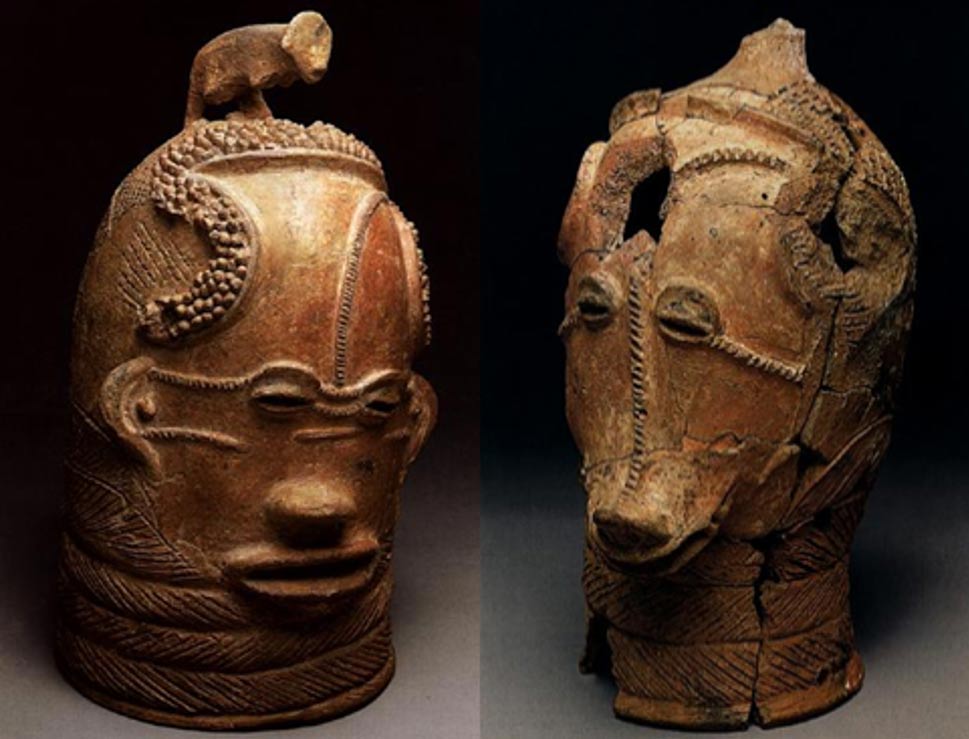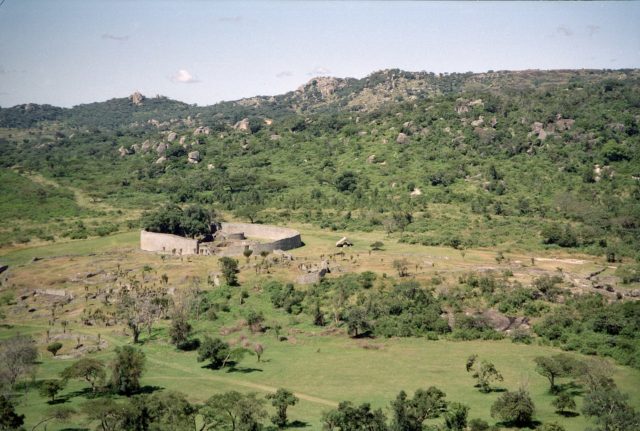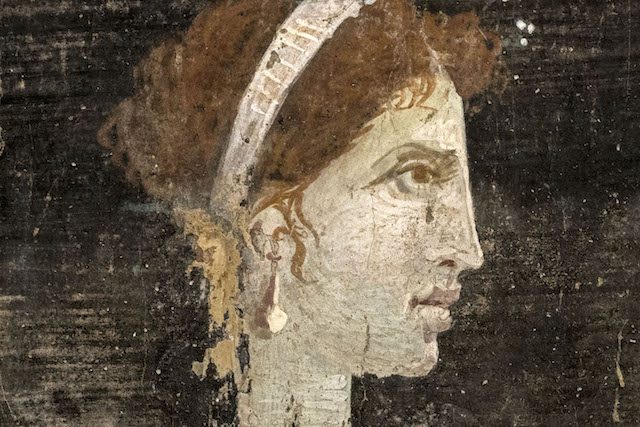The African continent has always fascinated explorers, treasure hunters, educational TV show producers, and other like-minded individuals. As the cradle of humankind, much of it has been extensively explored and studied in the past few centuries, though we still haven’t been able to solve some of its most enduring mysteries.
10. Lydenburg Heads

The Lydenburg Heads are a set of seven terracotta heads accidentally discovered by a ten-year-old boy – Ludwig von Bezing – in the South African town of Lydenburg. Beginning in 1957, he found remnants of the sculptures and other artifacts like iron and copper beads, pottery, and even pieces of bones at the same site. The discovery would have gone entirely unnoticed if he didn’t bring it to the archeology department at the University of Cape Town, resulting in an even bigger excavation effort by local archeologists.
While the structures are intricate and full of archeological detail, we still don’t know exactly who made them. Some believe that they were originally used as religious objects by the Iron Age Bantu-speaking people – a broad group of pastoral tribes spread across Africa. That could be true, though we know surprisingly little about them, too. Even today, the Bantu are made up of multiple different groups and tribes with distinct cultural characteristics.
9. Great Zimbabwe Ruins

Spread across more than 1,800 acres in modern-day Zimbabwe, the Great Zimbabwe Ruins are the remains of an ancient city that existed between the 11th and 15th centuries. The ruins include a complex of stone walls, towers, and enclosures that could have been parts of a palace, along with a number of other buildings. Over the years, archeologists have uncovered evidence of an advanced and sophisticated civilization that traded with faraway lands, including the Arab world and China.
Beyond that, though, we know little about these remains. They were first described by European travelers in the late 19th century, and some even claimed that they were the work of an ancient lost white civilization. The idea has since been debunked, and the question of who built Great Zimbabwe and where they came from remains a subject of debate. Some scholars argue that the builders were indigenous, like the Bantu-speaking Shona tribe, while others propose that they were migrants from the coast or north Africa.
8. Dabous Giraffes
The Dabous Giraffes and its surrounding rock carvings were first recorded by a French archeologist, Christian Dupuy, in 1987. It’s a set of more than 800 petroglyphs, named after two of its largest and most impressive engravings in the form of giraffes. They’re believed to be anywhere between 6,000 and 8,000 years old, making them some of the oldest works of rock art in the world. The larger giraffe is at least 18 feet tall, making it by far the largest petroglyph we’ve ever discovered.
While it’s clear that a lot of effort went into making them, we still don’t know exactly who made them. Apart from the giraffes, the Dabous site is home to multiple other kinds of engravings, including various forms of animals, humans, and human-animal hybrids. While they’re now located in a remote part of the Sahara desert, the region would have probably been a vast savannah back when these petroglyphs were first made.
7. Lost City Of The Kalahari
In 1885, a Canadian explorer named William Leonard Hunt claimed to have discovered the remains of a mythical lost city in the deserts of southern Africa, now known as the Lost City of the Kalahari. Under his pseudonym, Guillermo Farini, he wrote about elaborate ruins made of stone, including a section that looked like the Great Wall of China, and backed it with sketches and photographs taken by his son.
While we don’t yet know if Hunt actually found something, his accounts have spawned at least 30 expeditions in the years since. In 1964, an explorer called A.J. Clement tried to retrace his route and came across some weird rock formations. While it’s possible that Hunt mistook them for ruins of an ancient civilization, it’s also possible that this was a completely different region of the Kalahari than the one he described, as his account didn’t point towards any specific location.
6. Where Is Cleopatra’s Tomb?

Cleopatra, the famous last ruler of the Ptolemaic Kingdom of Egypt, was a powerful queen who ruled over the country for more than 20 years. She is still remembered for her beauty and intellect, as well as her infamous relationships with Julius Caesar and Marc Antony, both of which had profound effects on Egypt and Rome.
While we know quite a few details about her life, we don’t know what happened to her after she died. Cleopatra’s tomb is one of the most enduring mysteries from the ancient Egyptian era, largely due to the mysterious circumstances of her death. According to legend, Cleopatra was buried alongside Marc Antony after their defeat against Octavian, though it’s also possible that she fled Rome before her death. According to the theories, it could be deep in the seas around her palace, in a temple in Taposiris Magna, or in the port city of Alexandria.
5. Mount Lico
In 2012, a conservation biologist called Julian Bayliss discovered something peculiar on top of an isolated mountain in Mozambique. Using Google Earth, he found an entire rainforest on top of Mount Lico – a towering structure that had been known to the locals for centuries, though no one had ever been able to climb it.
In 2018, Bayliss gathered a team of scientists, biologists, rock climbers, and other experts to finally scale it. What they discovered might be one of the last unexplored places on Earth, as the forest was entirely undisturbed by human presence till that point. They found entirely new species of mammals and reptiles, including one unknown amphibian species, and they’ve only just started studying the place. They also found some upturned pots at the base of a stream, which could indicate human presence of some kind in the past.
4. Eye Of The Sahara

The Eye of the Sahara, also known as the Richat Structure, is a massive circular geological feature located in the desert of Mauritania, West Africa. It measures around 30 miles in diameter, making it one of the few natural structures on Earth visible from space. It’s made up of a concentric ring of rocky ridges and is thought to have been created by erosion over millions of years, though that’s only one of the many theories regarding its origins.
According to scientists, it could have been formed in a variety of other ways. We know that it’s not a volcano, as previously thought, or related to any known tectonic activity. Some believe that it’s a meteorological impact site, though the structure lacks the characteristic central peak and raised rim of meteor craters. Currently, the most widely accepted theory is that it’s a geological dome formed by complex erosion patterns over millions of years, even if that doesn’t explain its unique, almost-perfect circular shape.
3. KV55
The story of the KV55 tomb began in 1907, when it was first discovered during an archeological expedition in the Egyptian Valley of Kings. On first look, it was a wholly unremarkable tomb, with few engravings or other decorations separating it from other tombs nearby. It contained a single mummified body, along with a few artifacts belonging to multiple people.
It’s been more than a century since KV55 was first discovered, though we still have no idea regarding the circumstances of the burial, or even who the tomb belongs to. The most widely-believed theory points towards the Pharaoh Akhenaten, as carbon dating shows that the body found inside is closely related to his father, King Tutankhamen. Moreover, there’s evidence to prove that the tomb was not made for him, and was instead intended for a woman, possibly his queen, Nefertiti, or perhaps one of his other wives, Kiya.
2. Gedi Ruins
While locals had likely known about the site for much longer, the Gedi ruins near the eastern coast of Kenya were first discovered by the outside world in the 1920s. However, it wouldn’t be until 1948 that a British archeologist, James Kirkman, carried out detailed excavations of the area. He soon realized that he had discovered an ancient city that had no records in local legends, or any other historical traces of its existence within the larger region.
The Gedi site is now one of the most mysterious historical sites in Africa, mostly because of how elaborate it is. Likely built some time in the 13th century, the settlement occupies an area of at least 44 hectares, with two sets of walls segregating the rich and middle class residents of the city. Ruins of mud and wattle houses are still visible, including urban improvements like water wells and sophisticated drainage and sewage systems.
1. Sao Civilization
The Sao civilization was a mysterious ancient culture that flourished in central Africa from the sixth century BC to the 15th century AD, making it perhaps one of the longest-lasting civilizations in history. We know of their existence from a wealth of archaeological evidence, including stone carvings, pottery, and metal objects, as well as oral records.
There’s still quite a bit of mystery surrounding the Sao, as we don’t know anything about their language, origins, or culture. According to the traditions of their modern descendants – the Kotoko people – the Sao were a race of giants that lived somewhere between Nigeria and Cameroon.
We do know, however, that they were an influential group of people, and traded with other kingdoms in the region and beyond for hundreds of years. One theory says that they descended from the Hyksos people – a Palestinian dynasty that ruled over much of ancient Egypt at one point.